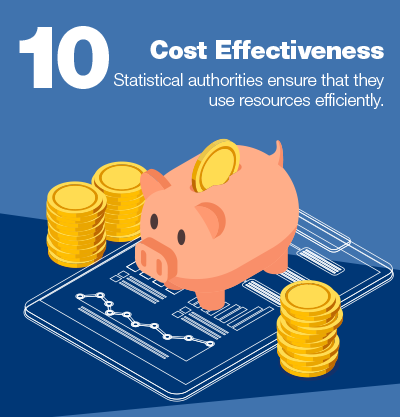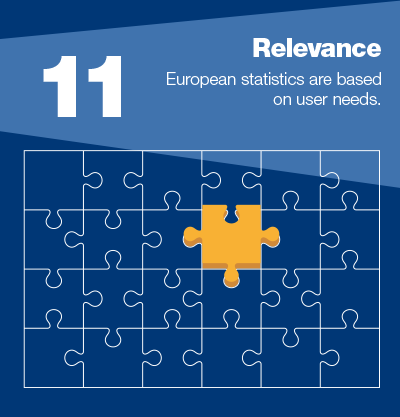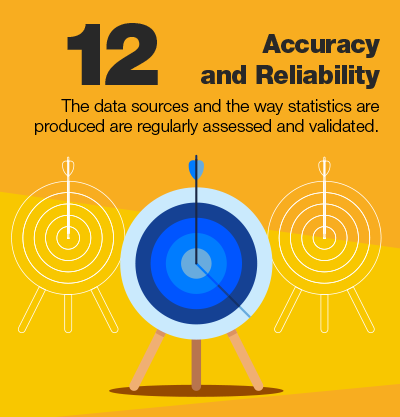European Statistics Code of Practice
When compiling statistics, Statistics Finland observes the European Statistics Code of Practice (CoP) and the Quality Assurance Framework (QAF) supplementing them.
The Code of Practice concerns the independence and accountability of statistical authorities and the quality of processes and data to be published. The principles are in line with the Fundamental Principles of Official Statistics approved by the United Nations Statistics Division and are supplementary to them. The principles are also compatible with those of the European Foundation for Quality Management (EFQM).
- European Statistics Code of Practice in English, 2017 version (PDF)
- Quality Assurance Framework (Eurostat, PDF)
The European Commission confirmed the Code of Practice in 2005. The present version was approved by the European Statistical System Committee in 2017. The Quality Assurance Framework QAF is version 2.0 from 2019.
The 16 principles
The 16 principles of the European Statistics Code of Practice cover the institutional environment, the statistical production processes and the output of statistics.
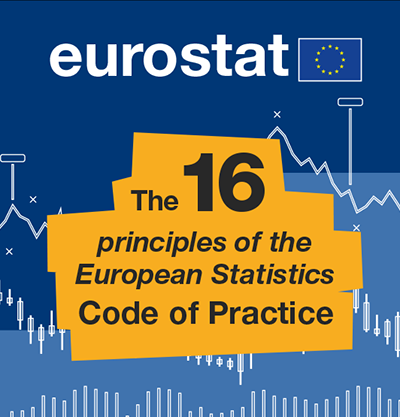
Principle 1: Professional independence
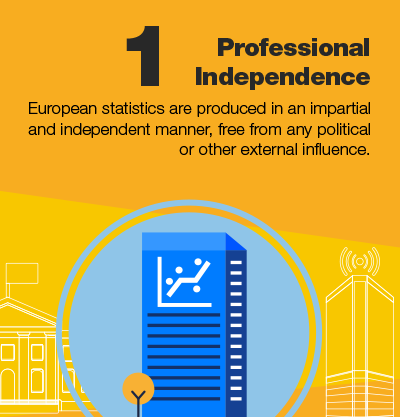
Professional independence of statistical authorities from other policy, regulatory or administrative departments and bodies, as well as from private sector operators, ensures the credibility of European Statistics.
- The independence of the National Statistical Institutes and Eurostat from political and other external interference in developing, producing and disseminating statistics is specified in law and assured for other statistical authorities.
- The heads of the National Statistical Institutes and of Eurostat and, where appropriate, the heads of other statistical authorities have sufficiently high hierarchical standing to ensure senior level access to policy authorities and administrative public bodies. They are of the highest professional calibre.
- The heads of the National Statistical Institutes and of Eurostat and, where appropriate, the heads of other statistical authorities have responsibility for ensuring that statistics are developed, produced and disseminated in an independent manner.
- The heads of the National Statistical Institutes and of Eurostat and, where appropriate, the heads of other statistical authorities have the sole responsibility for deciding on statistical methods, standards and procedures, and on the content and timing of statistical releases, see the Statistics Finland Act and the Decree on Statistics Finland (PDF, 1 p.)
- The statistical work programmes are published and periodic reports describe progress made, see Statistics Finland's annual programme (PDF, 49 pp., in Finnish).
- Statistical releases are clearly distinguished and issued separately from political/policy statements.
- The National Statistical Institutes and Eurostat and, where appropriate, other statistical authorities, comment publicly on statistical issues, including criticisms and misuses of statistics as far as considered suitable.
- The procedures for the recruitment and appointment of the heads of the National Statistical Institutes and Eurostat and, where appropriate, the statistical heads of other statistical authorities, are transparent and based on professional criteria only, see the Government’s recruitment principles (on the pages of the Ministry of Finance). The reasons on the basis of which the incumbency can be terminated are specified in the legal framework. These cannot include reasons compromising professional or scientific independence.
Principle 1bis: Coordination and cooperation

National Statistical Institutes and Eurostat ensure the coordination of all activities for the development, production and dissemination of European statistics at the level of the national statistical system and the European Statistical System, respectively. Statistical authorities actively cooperate within the partnership of the European Statistical System, so as to ensure the development, production and dissemination of European statistics.
- The National Statistical Institutes coordinate the statistical activities of all other national authorities that develop, produce and disseminate European statistics. They act in this regard as the sole contact point for Eurostat on statistical matters. Legislation and well defined and established procedures are in place for implementing the coordination role at both national and European levels.
- National guidelines to ensure quality in the development, production and dissemination of European statistics within the national statistical system are produced by the Heads of the National Statistical Institutes, where necessary; their implementation is monitored and reviewed.
- Statistical authorities continuously maintain and develop cooperation at various levels with each other and with the advisory bodies of the European Statistical System, as well as with the members of the European System of Central Banks, academic institutions and other international bodies, as appropriate.
Principle 2: Mandate for data collection and access to data
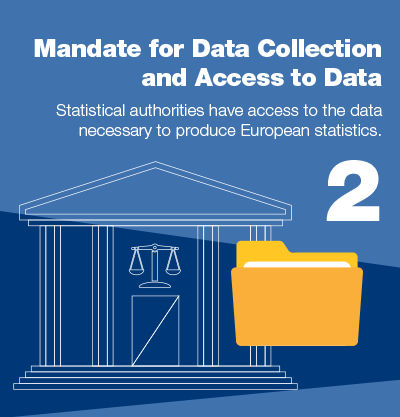
Statistical authorities have a clear legal mandate to collect information for European statistical purposes. Administrations, enterprises and households, and the public at large may be compelled by law to allow access to or deliver data for European statistical purposes at the request of statistical authorities.
- The mandate of the statistical authorities to collect and access information from multiple data sources for the development, production and dissemination of European Statistics is specified in law.
- The statistical authorities are allowed by law to access administrative data, promptly and free of charge, and use them for statistical purposes. They are involved from the beginning in the design, development and discontinuation of administrative records, in order to make them more suitable for statistical purposes.
- On the basis of a legal act, the statistical authorities may compel response to statistical surveys.
- Access for statistical purposes to other data, such as privately held data, is facilitated, while ensuring statistical confidentiality and data protection.
Principle 3: Adequacy of resources

The resources available to statistical authorities are sufficient to meet European Statistics requirements.
- Human, financial and technical resources, adequate both in magnitude and in quality, are available to meet statistical needs, see Statistics Finland's strategy and performance agreement (PDF, 15 pp., in Finnish)
- The scope, level of detail and costs of statistics are commensurate with needs.
- Procedures exist to assess and justify demands for new statistics against their cost.
- Procedures exist to assess the continuing need for all statistics, to see if any can be discontinued or curtailed to free up resources.
Principle 4: Commitment to quality
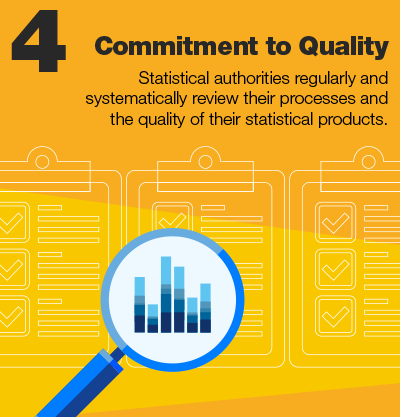
Statistical authorities are committed to quality. They systematically and regularly identify strengths and weaknesses to continuously improve process and output quality.
- Quality policy is defined and made available to the public, see the quality assurance from producers of Official Statistics of Finland. An organisational structure and tools are in place to deal with quality management, see the Quality Guidelines Handbook.
- Procedures are in place to plan, monitor and improve the quality of the statistical processes, including the integration of data from multiple data sources, see internal audit of statistics (in Finnish) and Eurostat's peer review (on Eurostat's pages).
- Output quality is regularly monitored, assessed with regard to possible trade-offs, and reported according to the quality criteria for European Statistics, see the quality reports of European statistics (Eurostat’s pages, PDF, 166 pp.) and the quality descriptions for the Official Statistics of Finland according to the quality report standards.
- There is a regular and thorough review of the key statistical outputs using also external experts where appropriate.
Principle 5: Statistical confidentiality and data protection

The privacy of data providers (households, enterprises, administrations and other respondents), the confidentiality of the information they provide and its use only for statistical purposes are absolutely guaranteed.
- Statistical confidentiality is guaranteed in the EU's General Data Protection Regulation (PDF) and the Statistics Act and penalties are prescribed for any wilful breaches of statistical confidentiality.
- Staff sign legal confidentiality commitments (PDF, 1 p., in Finnish) on appointment.
- The safety and integrity of statistical data are protected by physical, technological and organisational provisions, for example, within the agency statistical data are available only to those having been granted a licence to use them.
- The personnel has been given guidelines and instructions on the protection of data when compiling statistics.
- Strict operating rules and technological provisions are applied to research use of unit-level observation data, see instructions for application for a licence to use statistical data.
Principle 6: Impartiality and objectivity
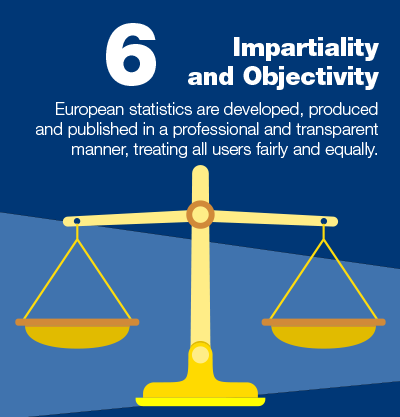
Statistical authorities develop, produce and disseminate European Statistics respecting scientific independence and in an objective, professional and transparent manner in which all users are treated equitably.
- Statistics are compiled on an objective basis determined by statistical considerations.
- Choices of data sources and statistical methods as well as decisions about the dissemination of statistics are based on statistical considerations.
- Errors discovered in published statistics are corrected at the earliest possible date and publicised, see guidelines on changes to statistical data, release guidelines of OSF.
- Information on data sources, methods and procedures used is publicly available, descriptions of statistics.
- Statistical release dates and times are pre-announced (in the release calendar).
- Advance notice is given on major revisions or changes in methodologies, see guidelines on changes to statistical data, release guidelines of OSF.
- Statistical authorities independently decide on the time and content of statistical releases, while taking into account the goal of providing complete and timely statistical information. All users have equal access to statistical releases at the same time, see the release calendar, the release guidelines of OSF. Any privileged pre-release access to any outside user is limited, well-justified, controlled and publicised. In case of breach, pre-release arrangements are reviewed so as to ensure impartiality.
- Statistical releases and statements made in press conferences are objective and non-partisan.
Principle 7: Sound methodology
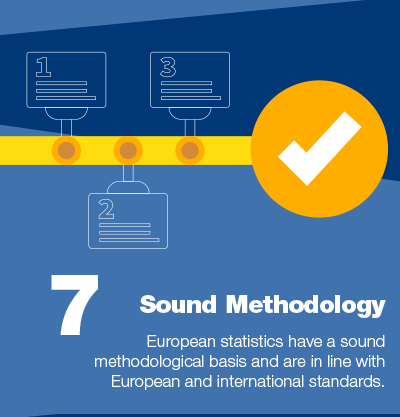
Sound methodology underpins quality statistics. This requires adequate tools, procedures and expertise.
- The overall methodological framework used for European Statistics follows European and other international standards, guidelines, and good practices, while constantly striving for innovation.
- Procedures are in place to ensure that standard concepts, definitions, classifications and other types of standards are consistently applied throughout the statistical authority, see the concepts database and the classification database.
- The registers and frames used for European Statistics are regularly evaluated and adjusted if necessary in order to ensure high quality.
- Detailed concordance exists between national classifications systems and the corresponding European systems.
- Graduates in the relevant academic disciplines are recruited, see training and the Government's recruitment guidelines (on the pages of the Ministry of Finance, in Finnish).
- Statistical authorities implement a policy of continuous vocational training for their staff, e.g. training programme in statistical skills (in Finnish).
- Statistical authorities maintain and develop cooperation with the scientific community to improve methodology, the effectiveness of the methods implemented and to promote better tools when feasible.
Principle 8: Appropriate statistical procedures
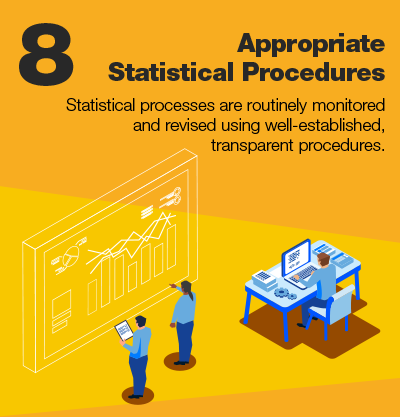
Appropriate statistical procedures, implemented through the statistical processes, underpin quality statistics.
- When European Statistics are based on administrative and other data, the definitions and concepts used for non-statistical purposes are a good approximation to those required for statistical purposes.
- In the case of statistical surveys, questionnaires are systematically tested prior to the data collection, e.g. in Statistics Finland's Survey Laboratory.
- Statistical processes are routinely monitored and revised as required.
- Metadata related to statistical processes are managed throughout the statistical processes and disseminated, as appropriate.
- Revisions follow standard, well-established and transparent procedures, see instructions.
- Agreements are made with holders of administrative and other data which set out their shared commitment to the use of these data for statistical purposes.
- Statistical authorities co-operate with holders of administrative and other data in assuring data quality.
Principle 9: Non-excessive burden on respondents

The reporting burden is proportionate to the needs of the users and is not excessive for respondents. The statistical authorities monitor the response burden and set targets for its reduction over time.
- The range and detail of European Statistics demands is limited to what is absolutely necessary.
- The response burden is spread as widely as possible over survey populations and monitored by the statistical authority.
- The data sought from businesses is, as far as possible, readily available from their accounts and electronic means are used where possible to facilitate its return, see data collection principles and data on data collection pages.
- Administrative and other data sources are used whenever possible to avoid duplicating requests for data.
- Data sharing and data integration, while adhering to confidentiality and data protection requirements, are promoted to minimise response burden.
- Statistical authorities promote measures that enable the linking of data sources in order to minimise response burden.
- Internal and independent external measures monitor the statistical authority’s use of resources.
- The productivity potential of information and communication technology is being optimised for the statistical processes.
- Proactive efforts are made to improve the statistical potential of administrative and other data sources and to limit recourse to direct surveys. The Statistics Act and the EU's General Data Protection Regulation (PDF, 88 pp.) form the legal basis for the combination of data sets.
- Statistical authorities promote, share and implement standardised solutions that increase effectiveness and efficiency.
- Procedures are in place to consult users, to monitor the relevance and value of existing statistics in meeting their needs, and to consider and anticipate their emerging needs and priorities. Innovation is pursued to continuously improve statistical output.
- Priority needs are being met and reflected in the work programme.
- User satisfaction is monitored on a regular basis and is systematically followed up.
- The strategy outlines the major development needs of statistics production.
- During the annual planning of the activity, the relevance of the stock of statistics is evaluated.
- Chargeable services ensure that the information needs of small customer groups are met, see Statistics Finland's products and services.
- The development of the usability of data in accordance with the principles of open data enable us to satisfy new information needs.
- Statistics Finland takes an active part in the development of statistics production in international collaboration with Eurostat and the OECD, for instance.
- Source data, integrated data, intermediate results and statistical outputs are regularly assessed and validated.
- Sampling errors and non-sampling errors are measured and systematically documented according to the European standards.
- Revisions are regularly analysed in order to improve source data, statistical processes and outputs, see instructions for revision situations.
Principle 13: Timeliness and punctuality
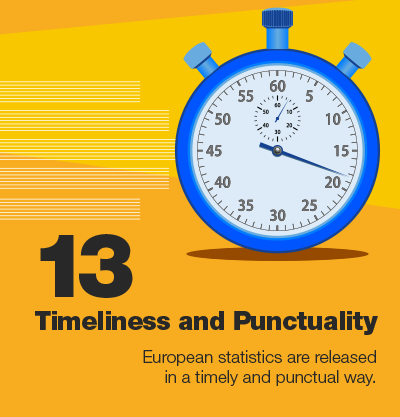
European Statistics are released in a timely and punctual manner.
- Timeliness meets European and other international release standards.
- A standard daily time for the release of statistics is made public, see the release calendar.
- The periodicity of statistics takes into account user requirements as much as possible.
- Divergence from the dissemination time schedule is publicised in advance, explained and a new release date set, see instructions for revision situations.
- Preliminary results of acceptable aggregate accuracy and reliability can be released when considered useful.
Principle 14: Coherence and comparability
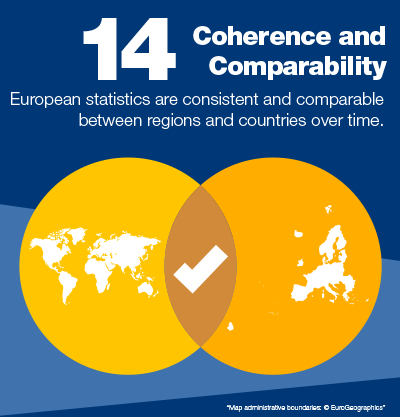
European Statistics are consistent internally, over time and comparable between regions and countries; it is possible to combine and make joint use of related data from different sources.
- Statistics are internally coherent and consistent (i.e. arithmetic and accounting identities observed).
- Statistics are comparable over a reasonable period of time.
- Statistics are compiled on the basis of common standards with respect to scope, definitions, units and classifications in the different surveys and data sources, see the concepts database, the classification database and the Quality Guidelines Handbook.
- Statistics from the different data sources and of different periodicity are compared and reconciled.
- Cross-national comparability of the data is ensured within the European Statistical System through periodical exchanges between the European Statistical System and other statistical systems. Methodological studies are carried out in close cooperation between the Member States and Eurostat.
Principle 15: Accessibility and clarity
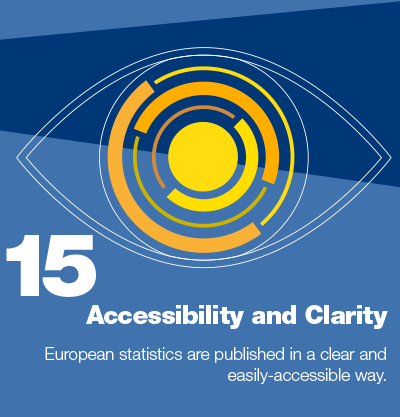
European Statistics are presented in a clear and understandable form, released in a suitable and convenient manner, available and accessible on an impartial basis with supporting metadata and guidance.
- Statistics and the corresponding metadata are presented, and archived, in a form that facilitates proper interpretation and meaningful comparisons.
- Dissemination services use modern information and communication technology, methods, platforms and open data standards.
- Custom-designed analyses are provided when feasible and the public is informed, see special compilations.
- Access to microdata is allowed for research purposes and is subject to specific rules or protocols, see conditions.
- Metadata related to outputs are managed and disseminated by the statistical authority according to the European standards.
- Users are kept informed about the methodology of statistical processes including the use and integration of administrative and other data.
- Users are kept informed about the quality of statistical outputs with respect to the quality criteria for European Statistics.

